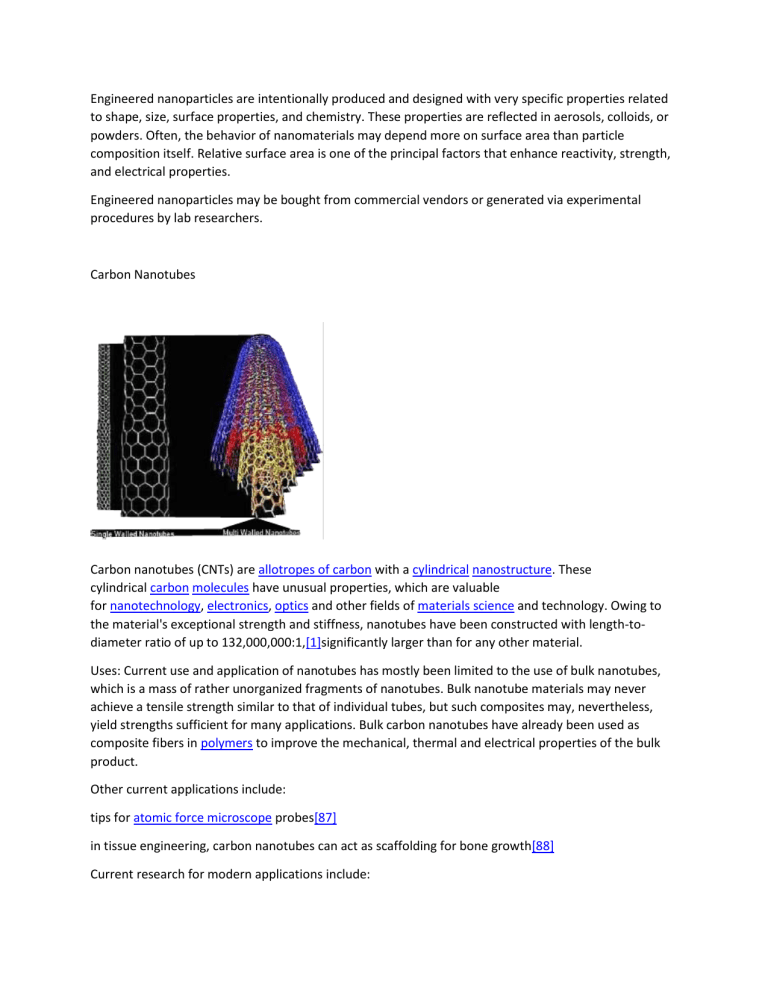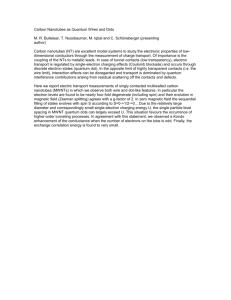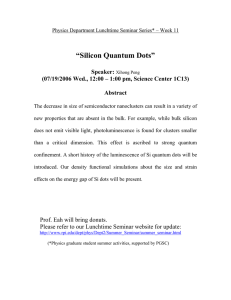Engineered nanoparticles are intentionally produced and designed with very specific properties related to shape
advertisement

Engineered nanoparticles are intentionally produced and designed with very specific properties related to shape, size, surface properties, and chemistry. These properties are reflected in aerosols, colloids, or powders. Often, the behavior of nanomaterials may depend more on surface area than particle composition itself. Relative surface area is one of the principal factors that enhance reactivity, strength, and electrical properties. Engineered nanoparticles may be bought from commercial vendors or generated via experimental procedures by lab researchers. Carbon Nanotubes Carbon nanotubes (CNTs) are allotropes of carbon with a cylindrical nanostructure. These cylindrical carbon molecules have unusual properties, which are valuable for nanotechnology, electronics, optics and other fields of materials science and technology. Owing to the material's exceptional strength and stiffness, nanotubes have been constructed with length-todiameter ratio of up to 132,000,000:1,[1]significantly larger than for any other material. Uses: Current use and application of nanotubes has mostly been limited to the use of bulk nanotubes, which is a mass of rather unorganized fragments of nanotubes. Bulk nanotube materials may never achieve a tensile strength similar to that of individual tubes, but such composites may, nevertheless, yield strengths sufficient for many applications. Bulk carbon nanotubes have already been used as composite fibers in polymers to improve the mechanical, thermal and electrical properties of the bulk product. Other current applications include: tips for atomic force microscope probes[87] in tissue engineering, carbon nanotubes can act as scaffolding for bone growth[88] Current research for modern applications include: using carbon nanotubes as a scaffold for diverse microfabrication techniques.[89] energy dissipation in self-organized nanostructures under influence of an electric field.[90] using carbon nanotubes for environmental monitoring due to their active surface area and their ability to absorb gases.[91] Importance: As a result of their good physical and chemical properties such as the strongest and stiffest materials yet discovered in terms of tensile strength and elastic modulus respectively and good electrical and thermal conductor, Examples: Using carbon nanotubes in the cathode layer of a battery that can be produced on almost any surface. The battery can be formed by simply spraying layers of paint containing the components needed for each part of the battery. Carbon nanotubes can perform as a catalyst in a fuel cell, avoiding the use of expensive platinum on which most catalysts are based. Researchers have found that incorporating nitrogen and iron atoms into the carbon lattice of nanotubes results in nanotubes with catalytic properties. Reseachers at MIT have developed a sensor using carbon nanotubes embedded in a gel; that can be injected under the skin to monitor the level of nitric oxide in the bloodstream. Researchers have demonstrated artificial musclescomposed of yarn woven with carbon nanotubes and filled with wax. Tests have shown that the artificial muscles can lift weights that are 200 times heavier than natural muscles of the same size. Nanotubes bound to an antibody that is produced by chickens have been shown to be useful in lab tests to destroy breast cancer tumors. The antibody-carrying nanotubes are attracted to proteins produced by one type of breast cancer cell. Once attached to these cells, the nanotubes absorb light from an infrared laser, incinerating the nanotubes and the attached tumor. Nanoparticle In nanotechnology, a nanoparticle is defined as a small object that behaves as a whole unit in termsof its transport and properties. It is further classified according to size: in terms of diameter. Particles in the nano range are beinginvestigated for a number of applications, like:wear resistance, scratch protection, blocking of light. Nanoparticles are of great scientific interest as they are effectively a bridge between bulk materials and atomic or molecular structures. Nanoparticles often have unexpected visible properties because they are small enough to confine their electrons and produce quantum effects. For example gold nanoparticles appear deep red to black in solution. Nanoparticles have a very high surface area to volume ratio. This provides a tremendous driving force for diffusion, especially at elevated temperatures. Other application examples of nanoparticles are: • Filter media. The active component is an alumina (AlOOH) fiber two nanometers in diameter.The nano alumina fiber is highly electropositive, and will attract and retain particles.• Silver has long been known to inhibit oxygen exchange, effectively killing bacteria. Nanosilver has been demonstrated to enhance that effect, and iscurrently being used in wound dressings for critical-burn victims.• Other nanoparticles can be used as pharmaceuticalcarriers to specifically deliver disease-fightingdrugs to afflicted body areas, thus minimizingsecondary effects.• In fuel cells perovskites are being discussed aselectrode materials for use as cathodes.Specifically the high surface area and the high ionicconductivity of the material is of interest. Quantum Dots Quantum dots are semiconductor whose excitons are confined in all threespatial dimensions. Basically a single electron trapped inside a cage of atoms and when the dot is exposed to a pulse of light at the right time andwavelength, the electron is raised to an exited state. Thus when the electron fall back to its groundstate, these dots then have the ability to glow. Quantum dots are a special class of materials known as semiconductor. Quantum dots are very special because they are so small that 4,000,000 dotstake up 2cm. At these small sizes quantum dots enable never before seen appications to scienceand technology. New markets and applications emerges as we continue to innovate, works andmaster the quantum dot technology. Quantum dots can be precisely controlled to do all kinds of useful things. School-level physics tells us that if you give an atom energy, you can "excite" it: you can boost an electron inside it to a higher energy level. When the electron returns to a lower level, the atom emits a photon of light with the same energy that the atom originally absorbed. The color (wavelength and frequency) of light an atom emits depends on what the atom is; iron looks green when you excite its atoms by holding them in a hot flame, while sodium looks yellow, and that's because of the way their energy levels are arranged. The rule is that different atoms give out different colors of light. All this is possible because the energy levels in atoms have set values; in other words, they are quantized. Quantum dots do the same trick—they also have quantized energy levels—but dots made from the same material (say, silicon) will give out different colors of light depending on how big they are. The biggest quantum dots produce the longest wavelengths (and lowest frequencies), while the smallest dots make shorter wavelengths (and higher frequencies); in practice, that means big dots make red light and small dots make blue, with intermediate-sized dots producing green light (and the familiar spectrum of other colors too). The explanation for this is (fairly) simple. A small dot has a bigger band gap (crudely speaking, that's the minimum energy it takes to free electrons so they'll carry electricity through a material), so it takes more energy to excite it; because the frequency of emitted light is proportional to the energy, smaller dots with higher energy produce higher frequencies (and shorter wavelengths). Larger dots have more (and more closely) spaced energy levels, so they give out lower frequencies (and longer wavelengths). quantum dots have attracted most interest because of their interesting optical properties: they're being used for all sorts of applications where precise control of colored light is important. In one simple and relatively trivial application, a thin filter made of quantum dots has been developed so it can be fitted on top of a fluorescent or LED lamp and convert its light from a blueish color to a warmer, redder, more attractive shade similar to the light produced by old-fashioned incandescent lamps. Quantum dots can also be used instead of pigments and dyes. Embedded in other materials, they absorb incoming light of one color and give out light of an entirely different color; they're brighter and more controllable than organic dyes (artificial dyes made from synthetic chemicals). quantum dots are being hailed as a breakthrough technology in the development of more efficient solar cells. In a traditional solar cell, photons of sunlight knock electrons out of a semiconductor into a circuit, making useful electric power, but the efficiency of the process is quite low. Quantum dots produce more electrons (or holes) for each photon that strikes them, potentially offering a boost in efficiency of perhaps 10 percent over conventional semiconductors. Quantum dots are also finding their way into computer screens and displays, where they offer three important advantages. First, in a typical LCD (liquid crystal display screen), the image you see is made by tiny combinations of red, blue, and green crystals (effectively color filters that switch on and off under electronic control) that are illuminated from behind by a very bright backlight. Quantum dots can be tuned to give off light of any color, so the colors of a quantum dot display are likely to be much more realistic. Second, quantum dots produce light themselves so they need no backlight, making them much more energy efficient (an important consideration in portable devices such as cellphones where battery life is very important). Third, quantum dots are much smaller than liquid crystals so they'd give a much higher-resolution image. Quantum dots are also brighter than a rival technology known as organic LEDs (OLEDs) and could potentially make OLED displays obsolete. Computers get faster and smaller every year, but a time will come when the physical limits of materials prevent them advancing any further, unless we develop entirely different technologies. One possibility would be to store and transmit information with light instead of electrons—a technology broadly known as photonics. Optical computers could use quantum dots in much the same way that electronic computers use transistors (electronic switching devices)—as the basic components in memory chips and logic gates. Quantum dots are also finding important medical applications, including potential cancer treatments. Dots can be designed so they accumulate in particular parts of the body and then deliver anti-cancer drugs bound to them. Their big advantage is that they can be targeted at single organs, such as the liver, much more precisely than conventional drugs, so reducing the unpleasant side effects that are characteristic of untargeted, traditional chemotherapy. Quantum dots are also being used in place of organic dyes in biological research; for example, they can be used like nanoscopic light bulbs to light up and color specific cells that need to be studied under a microscope. They're also being tested as sensors for chemical and biological warfare agents such as anthrax. Unlike organic dyes, which operate over a limited range of colors and degrade relatively quickly, quantum dyes are very bright, can be made to produce any color of visible light, and theoretically last indefinitely (they are said to be photostable). inside a cage of atoms and when the dot is exposed to a pulse of light at the right time andwavelength, the electron is raised to an exited state. Thus when the electron fall back to its groundstate, these dots then have the ability to glow. Quantum dots are a special class of materials knownas semiconductor. Quantum dots are very special because they are so small that 4,000,000 dotstake up 2cm. At these small sizes quantum dots enable never before seen appications to scienceand technology. New markets and applications emerges as we continue to innovate, works andmaster the quantum dot technology. Now the researchers are trying to harnest quantum dots full potential. Many applicationused is based on quantum dots such as:• used for LED • memory storage • solar cells and • diseaseIn the near future there will be a foldable wide screen TV, or a truly foldable phone, right in your pocket, instead of paint, you have walls which are screens that can display movies or tv shows,walls that can change colours to your mood, and help you get to sleep, and a newspaper thatactually only on a single surface. 4.Nanoshell A type of spherical nanoparticle consisting of a dielectric core which is covered by a thin metallic shell (usually gold). Nanoshells possess highly favorable optical and chemical properties for biomedical imaging and therapeutic applications. In addition, nanoshells offer other advantages over conventional organic dyes including improved optical properties. Nanoshells designed to absorb various wavelengths of light (the six vials on the right), including infrared (vial at far right) compared to gold colloid (far left). Nanoshell properties is chemically inert and water-soluble, can be used as efficient catalysts, forms stable dispersions and also nonmagnetic; therefore they can be useful in biological applications. In the near future, this type of nanoparticle can be used in dentistry for different applications, including treatment of severe gingival and periodontal infections, getting rid of oral and dental cancer cells, and possibly for soft tissue welding of inaccessible area. The nanoshellcan be stimulated with infrared light in which the nanoshell absorbs the energy of the light and consequently generates heat. Through this mechanism, nanoshells have a potential photothermal therapeutic ability to destroy bacteria and tumor cells. This method minimizes the risk of trauma to the adjacent tissues (Pattani and Tunnell, 2012). For this purpose, nanoshells are usually shuttled into tumors by the use of phagocytosis, where phagocytes engulf the nanoshells through the cell membrane to form an internal phagosome. In the next step, the cellular lysosomes fuse with the phagosome and form a phagolysosome in order to metabolize it. These nanoshells are not metabolized. Thus, in order to be effective, the nanoshells need to be within the tumor cells and photo-induction is needed (as described earlier) to terminate the tumor cells’ life. Additionally, the nanoshells, which are loaded with both cell-targeting agents (antibodies, proteins, etc.) and specific drugs (e.g., antibacterial or chemotherapeutic agents) can be used for targeted drug delivery (Lal et al., 2008). Another interesting application of the nanoshells is the tissue welding capability. Nanoshells may represent a rapid way for treatment of deep lacerations in an emergency room. Recently, a nanoshell-based solder (nanoshells incorporating with bovine serum albumin) has been applied to full thickness incisions, after which the incision areas were irradiated with infrared light for several minutes to start tissue welding and the results of wound healing was better than the control group and was comparable to the suture group (Loo et al., 2004). These results suggest the nanoshellsas a novel effective ligature/cautery method in deep gingival laceration or difficult accessible bleeding sites in dental tissues. https://www.openaccessjournals.com/articles/engineered-nanomaterials-for-pharmaceutical-andbiomedical-products-new-trends-benefits-andopportunities.htmlhttps://www.explainthatstuff.com/quantum-dots.html




